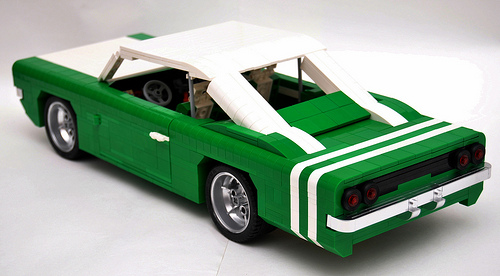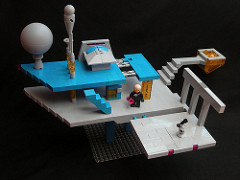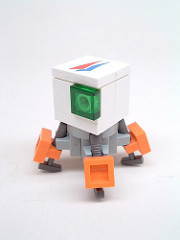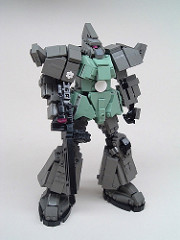69Zombieslayer puts the enduringly popular Hazmat minifigures to good use in this cinematic style wide-screen shot. In his terse description the builder asks you to imagine The A Team theme music in the background, but when I look at the photo all I hear is The Tower that Ate People. Your results may vary.
Posts by Keith Goldman
Skyline
Matt Hamann: Funky dynamic brake blisters – Boilerplate & Beyond Vol. 18
As a young Train-head, this week’s builder is a rare beast among our tribe. You may know Matt Hamann from his fine assortment of model engines and rolling stock or from his entertaining writing on the Twee Affect, but you’re about to know him much better. I sat down with Matt on a bicycle made for two about halfway through the Wabash Cannonball Trail in northwest Ohio. We talked about Los Campesinos!, Huffy vs. Roadmaster and the persistence of chain-slap.
The Build:

KG: What is the most challenging thing about building trains? Where do you stand on the classic 6 wide vs 8 wide debate, and do you also pine for exotic track geometries and 9 volt engines like so many Train-heads?
MH: The most challenging thing about building trains is that you have to recreate something out of a building toy. When building other themes, that is not always the issue since you are working from concept art or your imagination, unless, of course, you are building a scale model of a spaceship from a space opera, or an all terrain vehicle from a movie about dinosaurs. Modern locomotives have odd-shaped details everywhere and weird angles that do not translate easily into Lego; steam engines had greebles everywhere and moving bits that the builder has to selectively compress, yet still be able to make the model identifiable, not to mention that most steam engines are matte, whereas most Lego parts are glossy, which adds another challenge. But that is not to say that one is easier than the other; it is still a challenge to simply create something that is not yet another fighter ship or pile of grey bricks with a parapet, gate, and all your minifigs lined up perfectly in the courtyard.
I build 6 wide trains. When I joined my Lego train club in 2006, it is what my club mates were building and what our layout is scaled to. Bigger trains would just look silly among all the small buildings and cars and I am not about to start my own layout, not in this decade, at least. Bigger models can also be more parts intensive, which, depending on the model’s color and what pieces you are using, can be more expensive than building a smaller models. That point is especially important to me because I am (for now) a full-time student with only a part-time job. More and more I would rather spend my money on things other Lego, like camping gear and stuff for my touring bike, so to build smaller, less expensive models lets me keep doing both of my hobbies. I also like to be able to pull about 30 train cars with just two 9v motors, on unmodified wheels and transformers. Power Functions is changing that, but with the current system, you can’t beat light weight 6 wide trains if you are going for pulling the most train cars. I won’t say that building 8 wide is any easier than building 6 wide or visa-versa, if both are done right. Building a smaller model means selectively compressing more but you have the convenience of a lot of train specific parts (windscreens, grilles, etc.) that are mostly designed with 6 wide in mind.
If I had my own layout I would probably pine for a better system of track. Right now I don’t. I know for sure that my layout wouldn’t be 9v. 9v is dead. Power Functions is (supposedly) less expensive than 9v, which helps keep Lego in business, which keeps us AHOLs happy. Power Functions also does not have the connectivity issues that 9v has. Every little break between the tracks means lost current, so on large layouts, you have to have multiple power drops. If I had the resources I would probably build my layout to be in scale with 7 wide trains, since they are the best of both worlds.
KG: Many builders claim that Lego is a great stress-reliever. Do you find this to be true, and if it is, why do so many people seem to get stressed about it so easily?
MH: I am melancholic when I build. It feels great to be struck with inspiration, to solve problems, to finish a model, and to get good feedback and have discussions with other AHOLs, but, since I am so anal retentive, it can be stressful not to come up with a solution for a gap here or the funky dynamic brake blisters that GP7s and GP9s had. It can also be stressful to source the parts that you need, especially when they only came in a $50 Star Wars set from the mid 2000s and you need 20 when only 2 came in the set, in a color that Lego doesn’t make anymore. That scenario seems to happen a lot. With the financial involvement and the contrasting dogmas. it is really no wonder that people stress out.
KG: You’ve tried your hand at Steam Punk, but you failed to embrace many of its popular conventions. Talk about the theme, the good, the horrible and what direction is ripe for exploiting.
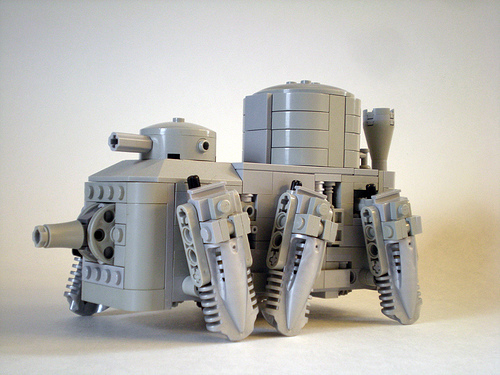
MH:The popular themes among fans draw inspiration from everywhere. Space builders draw inspiration from all the popular movies and series, train builders from the world’s trains, and castle builders from history, fantasy, and mythology. Lego steampunk seems like a giant circle jerk. Instead of looking outside of their community of practice, they have created an inbred style. That is not to say that there shouldn’t be common themes in the style, but that there should be more variety. Put away the parts from your Prince of Persia sets and your Jawa Sandcrawler and tear open those Power Miners sets that, for whatever reason you still keep sealed, and introduce some lime green to your build! Steal some of the Scala and Belville that you gave your daughters and put some light yellow and aqua your model! Look to World War One and interwar vehicles and aesthetics for inspiration. Most Studio Ghibli productions are a great source of inspiration.
Read the full interview after the jump!
Carter Baldwin: Just keep the furries out.-Boilerplate & Beyond Vol. 17
My next guest is from the post-LUGNET generation, a college-age wunderkind with a penchant for the machines of war. Carter Baldwin is an accomplished builder, collaborator and veteran of the American convention circuit who has inspired a legion of younger builders with his innovative designs. I sat down with Carter at Pat’s King of Steaks restaurant in Carter’s home town of Philadelphia at 3am PST. We talked about wine, women and song. We also talked about LEGO.
The Build
KG: I’ve read a few older builders grousing about how all the fancy new parts take all the skill and fun out of building. React to that attitude or to old cranky builders in general.
CB: I actually haven’t seen this attitude too much within the AFOL community, but I see it constantly whenever a build leaks out onto the wider internet. Invariably, there will be the ‘this is cheating, in my day we only had 2×4 bricks in three colors, and we liked it that way! there’s no creativity anymore!’ I hate that attitude. Tim Gould made an excellent graphic of all the one-use specialized parts that were available in 1980, but I can never track it down quickly enough to avoid remembering that arguing with internet strangers is a pyrrhic endeavor at best.
I’d agree that the ’90s saw a proliferation of useless parts that lead to the well documented juniorization of sets, but the past decade has been a bonanza of amazing new parts. In particular we’re seeing a lot more excellent small parts, which really boosts the fine grain detail that’s now possible. We’re seeing a lot less of the pixelation that used to define Lego builds. Fans of Lego who haven’t picked up a brick in a couple decades can’t deal with that, but I haven’t heard any actually active builders complaining.
KG: How important is it when designing a model that you employ a new technique? Does the want to use a specific technique ever drive a model? if so can you give an example.
CB: It’s become less important to me over time. When I first entered the internet community I tried to do that with every build, do something that hadn’t been tried before, or at least do it better than I’d seen it.
 I think now I build shapes rather than techniques. I have enough of a library of tricks that I don’t have to worry too much about how to achieve a connection, but forcing all those connections to form the shape I want is the new challenge. My Golem Hardsuit would be a good example; I knew the shapes I wanted to achieve; the techniques I came up with to get there weren’t particularly exciting or novel.
I think now I build shapes rather than techniques. I have enough of a library of tricks that I don’t have to worry too much about how to achieve a connection, but forcing all those connections to form the shape I want is the new challenge. My Golem Hardsuit would be a good example; I knew the shapes I wanted to achieve; the techniques I came up with to get there weren’t particularly exciting or novel.
And, in the end, I cribbed a ton of ideas from Chris and Rabadan.
KG: You recently took part in a popular and imitated Flickr Group called called World In Confict:2070. Describe this group to our readers and your experience as a participant of the group?
CB: World in Conflict started about two and a half years ago as a general repository for the various unconnected faction sorts of things that a bunch of us had floating around at the time – my own NATO faction, Craig’s South American Coalition, Forest’s amoral PMCs, Dane’s biomechanical atrocities, and others. We certainly didn’t start the trend of faction building – NickDean is probably the best known originator, but I’m pretty sure people have been building private armies for as long as Lego has had greyscale bricks.
Once we had all these factions under one roof, naturally the next step was to slug it out. We developed a complex ad hoc system that was part model UN, part wargaming, and part tabletop-style roleplaying and carved out a cyberpunk storyline that meshed with our collective vision for our imaginary universe. Since this was a long-term and long-distance group, we couldn’t simply play BrikWars in order to determine tactical prowess; instead, we built scenes to depict our movements on a more strategic scale.
 As much fun as we had with slaughtering the other sides cannon fodder and blowing up tanks/bunkers/cities, the really interesting thing that came out of the game was the storytelling. Due to the interest in the stories of the scenes we built, we created a public group for others to follow the WiC narrative, and I think it’s the persistent narrative of the game universe that inspired a number of similar groups.
As much fun as we had with slaughtering the other sides cannon fodder and blowing up tanks/bunkers/cities, the really interesting thing that came out of the game was the storytelling. Due to the interest in the stories of the scenes we built, we created a public group for others to follow the WiC narrative, and I think it’s the persistent narrative of the game universe that inspired a number of similar groups.
World in Conflict is two years old now and starting to show signs of winding down – while the game has always had lulls in activity between spikes of conflict, this latest hiatus has been particularly stubborn and long-lasting. But fans who have been watching the storyline don’t need to worry; there are plans to end at least the current incarnation of WiC with a proper finish.
Read the full interview after the jump!
Leigh Holcombe: The masked avenger inside us all – Boilerplate & Beyond Vol. 16
My next guest destroys the long held belief in the community that a builder must always keep the proper signal to noise ratio. Although Leigh Holcombe has a stable of well built and some might say handsome models, he may be best known for his numerous postings in various LEGO related fora. Armed with a sharp wit and a willingness to use it, this keen observer of the community has made his own mark through the years. I caught up with Leigh, better known as worker201, on a barren stretch of flatland about halfway between Houston and Waco Texas. We talked about the ELF, the WTO and ELO. We also talked about LEGO.
The Build
 KG: Your early builds were mostly in the sci-fi or military genres, but then you switched to chairs and a bit of town with J-Flo’s flower shop. Was there a reason behind the switch, and in a perfect world, what direction appeals to you the most? Do you think builders in general, get too locked into one genre?
KG: Your early builds were mostly in the sci-fi or military genres, but then you switched to chairs and a bit of town with J-Flo’s flower shop. Was there a reason behind the switch, and in a perfect world, what direction appeals to you the most? Do you think builders in general, get too locked into one genre?
LH: I think sci-fi is the geek default, because the designers in that field literally get paid to ignite the imaginations of their audience – being inspired by that genre is so easy. It’s a lot harder to get inspired while walking through IKEA, but I swear it does happen.
 I think this hobby is a textbook cross-section of different levels of obsession and focus – of course some builders get bogged down in a single genre, and some can’t sit still long enough to even have a genre. I’m somewhere in the middle – eventually, I’d like to build something castle or train, but I’ll probably make more spaceships too.
I think this hobby is a textbook cross-section of different levels of obsession and focus – of course some builders get bogged down in a single genre, and some can’t sit still long enough to even have a genre. I’m somewhere in the middle – eventually, I’d like to build something castle or train, but I’ll probably make more spaceships too.
KG: Many young builders begin by recreating the work of builders who came before them. You, however, came in on the ground floor of the hobby or very near to it, so where did you look when you started building?
LH: When I was a kid, back in the late 70s, there was nobody else – just me, the bricks, and the back of the box. I think that’s how it was for most AFOLs. My dark age ended when the Star Wars sets first came out – I couldn’t believe how awesome that first Snowspeeder set was. Then I got on the internet and found Shaun Sullivan’s AT-ST , which was really inspirational to me. He posted instructions for it, and they helped me to remember all the techniques I had forgotten. Realizing that something so awesome was made with basic bricks attached with normal clicking techniques really flipped a switch for me.
KG: Whether it is a job, school, deployment, health issue or even a stay in prison, like many builders, you have been in a position where you want to build for an extended period of time but have not been able to. As the time goes by does it make you think about LEGO more or less? Does it change your mind-set on building, and when you do get a chance to build, does it change anything?
LH: Oh, it’s tough. Lego is a creative outlet and a stress reliever, and not having it is like trying to quit smoking. Plus, keeping up with Flickr and TBB every day puts inspirational stuff in front of me all the time, and I can’t do anything about it. I have so many hypothetical projects lined up, and I’m afraid I’ll never get around to them. The only time I really get to build is when I visit my nephew – and then, I’m mostly making stuff to impress him, like big guns and weird minifig combinations.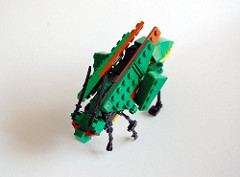
The Community
KG: You created a popular and polarizing fan-forum called Stajinaria when the equally popular and polarizing JLUG went down. Talk about those two forums, what they formed in a reaction to, why they ended and what they offered that was unique. Is AFOL 16+ the latest version of this tradition?
LH: I don’t know exactly what Janey and Ross were thinking when they started JLUG, but it pretty quickly became the home of community criticism. At that time, Lugnet and Classic Space Forums were dealing with censorship and leadership issues, and the people at JLUG seemed to enjoy calling out what they deemed hypocrisy and conservativism in those communities. After JLUG disappeared, a lot of its members decided that the group of people was more important than the site, so I took it upon myself to create a new home for “merry pranksters”. Someone accused JLUG once of being a ‘staging area’ where mischevious activists planned their shenanigans (not one of which was planned), which is where Stajinaria got its name.
Many of the core group are still internet friends today, but the mass migration of the community to Flickr made the forum extraneous, so I shut it down earlier this year. Both sites were based on the sandbox rule – if you don’t like the rules in someone else’s sandbox, make your own sandbox. AFOL 16+ was a sandbox that didn’t allow young kids, who were becoming an increasing annoyance in the Flickr Lego group. I think it started out with a bunch of venom and righteousness, but now I think of it as just another group of people who are familiar enough with each other to kid around and be sarcastic. (I also run Lego 35+, a place where grownups can interact, but nobody ever goes there.)
Read the full interview after the jump!
Gilcélio Chagas: If you die it’s my turn. – Boilerplate & Beyond Vol. 15
After a brief hiatus the Boilerplate & Beyond interview series returns with another baker’s dozen of builders from around the planet. This time around we’re starting in Brazil with Gilcélio Chagas who brings a much needed breath of fresh air to the hobby with his diverse mix of building skill, sense of adventure, Latin good looks and as this interview will illustrate, a way with the ladies. I recently sat down with Gilcélio, rocketing across the Third Bridge towards his home town of Vila Velhas. We talked about the Treaty of Tordesillas, Pele Vs. Messi and how Vila Velhas earned its nickname “the land of green shins”. We also talked about LEGO.
The Build
 KG: A perusal of your photo-stream on Flickr makes it clear that you love building large-scale cars. How do you approach building vehicles and which vehicle has been the most challenging to build?
KG: A perusal of your photo-stream on Flickr makes it clear that you love building large-scale cars. How do you approach building vehicles and which vehicle has been the most challenging to build?
GC: I don’t have a rule to make my builds, I always start with the difficult part of the car, that way I expend less time if I can’t make it. Of course it’s more common for me to start from the front, that in most cases has more details and requires more attention.
The most challenging vehicle for me comes from a movie called Gran Torino, directed by Clint Eastwood, the car gives the movie its name, and every time that I see the film I get crazy to make it in LEGO, the curves gives a difficult special touch in this adventure.
KG: When working on a difficult model, how much advice from other builders to you typically ask for, or do you prefer to go it alone? When you give building advice, do you consider the builder’s feelings or try to be as honest as possible?
GC: Sometimes it is important to ask for a second opinion, who is riding puts a bit of feeling in the assembly and it ends up getting in the end result, the second opinion can be used exactly for this, take away the sentimentalism part and assess impartially.
I think I asked for advice twice, the first was the Dodge Charger that I asked the opinion of Lino who gave important tips for the project and the second time was my most important project in the island desalination that I counted on help from Nannan who was a very important aid.
Thanks Lino and Nannan.
Giving this kind of advice is very complicated without knowing the inventory of the builder. Imagine that you request to modify some point of the project without knowing if they have the required piece or not. When I’m gonna give a tip I try to be honest, of course every project must have the characteristics of the builder.
KG: You have drawn inspiration from the ultimate video game system, the Atari 2600. Is it just nostalgia that drives you to build in 8-bit style or is there something more? Also, what games would you like to tackle in the future?
GC: When I started with Atari 2600 project, I had in my mind the idea to immortalize in Lego pieces the Atari games that a lot of people have never heard before, and I couldn’t let this important part of my childhood die in this way.
What made the Atari so good was the fact that if you wanted to play with someone you had to go into the house of a friend. There was nothing online, it was all in someone’s home and that made the game even cooler this interaction and simplicity of the games. “If you die it’s my turn.”
And that’s the reason that I’ve made my projects so simple, without many resources because Atari was like that, simple and captivating.
The Community
KG: Describe LUG Brasil. How did you come into contact with the LUG and what happens at a typical meeting? Both the United States and Brazil are among the most racially diverse countries on the planet, but unfortunately most American LUGs do not reflect this diversity. Can the same be said for Brazil?
GC: The LUG Brasil is an excellent place for Lego lovers like us, we have great builds there, challenges, meets, tips, and things related with this hobby that we have in common. My contact is basically by the internet and face to face meeting when it’s possible.
We have a good diversity of the Brazilian population, here you can find all kind of races, sex, religions etc. But the LEGO in Brasil is very expensive, sometimes the price is so high as to be 4 times greater in other countries, which makes LEGO access more difficult to the people with less purchasing power.
Read the full interview after the jump!
Deborah Higdon: Who’s Freddie Mercury? – Boilerplate & Beyond Vol. 14 [Interview]
At first glance, it appears that Keith Goldman has been joined by Edward Estlin Cummings for the 14th installment in our series of interviews. If all-caps is yelling, Deborah Higdon whispers her answers to Keith’s questions. Thankfully, Deborah’s answers are worth the extra effort to hear. Without further commentary on capitalization from me, take it away, Keith!
 They say that our hobby is dominated by mannkinder, and the closest we come to the feminine touch are our beloved bevy of gay men and the unfortunate epidemic of man-boobs. Our community meetings and events are virtual sausage festivals, with only the occasional long-suffering wife or girlfriend to break up the monotony. Even my own beloved interview series has been as they say in the armed forces “a mile of %&#@”, and with that in mind I sought out not only a great builder…but a real live woman. Many of you are familiar with Deborah Higdon for her outstanding architectural models, minifig scale furniture, and hatred for capital letters.
They say that our hobby is dominated by mannkinder, and the closest we come to the feminine touch are our beloved bevy of gay men and the unfortunate epidemic of man-boobs. Our community meetings and events are virtual sausage festivals, with only the occasional long-suffering wife or girlfriend to break up the monotony. Even my own beloved interview series has been as they say in the armed forces “a mile of %&#@”, and with that in mind I sought out not only a great builder…but a real live woman. Many of you are familiar with Deborah Higdon for her outstanding architectural models, minifig scale furniture, and hatred for capital letters.
I sat down with Deborah at the Palladium where the Ottowa Senators were tied going into overtime in round one of the NHL playoffs. We talked about how the O-Train got its name, high-sticking and how to assemble a Frojista from Ikea without an allen wrench.
The Build
Keith Goldman: In your Flickr profile you mention that you’re a frustrated architect at heart, a condition that is not unique in our hobby, how does that influence your subject matter or building in general?
Deborah Higdon: oooh, we’re starting off with a serious question. ;-) considering i mostly choose to moc buildings, i’d say the influence is pretty strong. strangely, i admire historic architecture most, probably equally for the craftsmanship that went into the details as well as the design of the building itself. i say strangely because i don’t tend to build historic styles. when admiring architecture, i prefer historic. when designing a complete house, i prefer modern, and not just because i find lego lends itself more “easily” to modern styles, it’s not about “easy”. modern building allows more leeway for an active imagination. on rare occasions, i think it’s fortunate i didn’t become an architect – i don’t think i could put up with the physical limitations of engineering (what do you mean i can’t have a waterfall flowing between the 2nd and 3rd floor, falling out of the wall to the sea below?) i’m not sure that i’d have been all that good at satisfying the client 100%. compromising something based on æsthetics would be very difficult for me. the influence also comes from the design blogs i’m addicted to. i’m trying to quit, looking for a blogs anonymous group, know any? the first step is admitting the problem.
KG: You’ve built extensively in both minifig and microscale. What do you like and dislike about each scale and would you ever consider mixing the two?
DH: i don’t think there’s anything i dislike about any scale. i might dislike the infamous proportions of the minifig, (i tell myself, it’s just a toy) but as all my afol friends know, i’m not fond of the minifig itself in my mocs, (blasphemous talk, i know. i know how tbb originated, sorry andrew!) so no problems for me. but all the houses and furnishings that i build are built with the minifig in mind. microscale building is my spouse’s favourite – it costs less, takes up less space to store and less time to build – he wins in all ways. as for what i do like about these scales, i like replicating. i think of the miniatures i used to collect. i looked for high quality representations of handicraft (shaker furniture, farm tools) but i never wanted a doll house for them, and certainly never the dolls to go with them. i see the houses that i build more as architectural models that happen to be in minifig scale. i’ve seen others mix the scales with great execution, but i’m not tempted yet.
KG: On both Flickr and Facebook you quote Einstein on curiosity:
The important thing is not to stop questioning. curiosity has its own reason for existing. one cannot help but be in awe when (one) contemplates the mysteries of eternity, of life, of the marvelous structure of reality. it is enough if one tries merely to comprehend a little of this mystery every day. never lose a holy curiosity.
What role does curiosity play in your building and what do you think about most often when you build? World conquest? Work? Freddie Mercury? The mysteries of the universe?”
DH: curiosity is huge for me, bane of my mother and father’s existence i was. i’m always looking at buildings, doors, windows, stairs, furniture and design elements and asking how can i make that in lego, what pieces can i use? can i make it on a smaller scale? can i make it look realistic. how can i make it stronger, can i get it to a fest? can i think of a new use for this piece? needless to say, i talk to myself a lot. thinking you ask? i think about dessert, martinis, new shoes, what makes people tick, what makes people not tick, what makes clocks tick. oh, sorry, i digress. you mean when i’m building. hmm, i think about chocolate, dark chocolate, which leads to dark chocolate bricks, and then leads to me lamenting that lego doesn’t make cream bricks, then the lack of earth colours in the palette comes to mind then i forget what i was going to build.
 i certainly don’t think of world conquest, i’m canadian, we don’t have that gene in our makeup. i never think about work, never, not while in the building zone. who’s freddy mercury? never mind, i can google him. sometimes the mysteries of the universe cross my mind.
i certainly don’t think of world conquest, i’m canadian, we don’t have that gene in our makeup. i never think about work, never, not while in the building zone. who’s freddy mercury? never mind, i can google him. sometimes the mysteries of the universe cross my mind.
More of Keith’s interview with Deborah after the jump: Continue reading
Dave Shaddix: I say it’s time to gas the nest – Boilerplate & Beyond Vol. 13 [Interview]
For our 13th installment, we join Keith Goldman as he interviews Dave Shaddix, usually one of the first to comment on these very interviews. As with Soren, Dave uses a few words that our more sensitive readers may find offensive. Once again, you’ve been warned. Take it away, Keith!
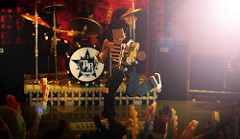 Unlike previous entries, this week’s builder isn’t a crusty 10-year veteran of the hobby, media magnate, self-stylized reverend or even Australian.
Unlike previous entries, this week’s builder isn’t a crusty 10-year veteran of the hobby, media magnate, self-stylized reverend or even Australian.
Instead I bring you an everyman from Anytown, U.S.A, who might be known better for his quick wit and devil-may-care attitude than for his growing library of great models. Dave Shaddix isn’t exactly a noob, but he also hasn’t been around long enough to be as jaded and rigid in his way of thinking than many of us gray-beards.
I sat down with Dave 2 miles from the US/Mexico border in Dave’s home state of Arizona. We talked about the Gadsden Purchase, Sabbath with Ozzie vs. Sabbath with Dio and what really happens to all those tourists who go missing every year in the Grand Canyon. We also talked about LEGO.
The Build
Keith Goldman: Like many builders out there, you’ve got a long term project going on. How long has your Papa Roach stage been in production and what are the challenges of a long term build from a relative newcomer’s perspective? Is your cousin and Papa Roach front-man Jacoby Shaddix involved in the process?
Dave Shaddix: I’ll first define ‘relative newcomer’ so that we’re all on the same page as far as timelines are concerned. I started building again about nine years ago with my oldest son; yeah it’s the DUPLO brick that brought me out of my dark age. As he grew, I started buying and building more age appropriate sets with him which eventually led me to the internet where I quietly trolled sites like Brickshelf and MOCpages from around 2006 to 2008 when I started posting on MOCpages. Arizona’s first LEGO retail store opened in the summer of 2008 and our LUG formed up immediately after. In short, 2008 is the year I became an actively-engaged AFOL who was fully out of the closet. Now that we have my own private definition of ‘newcomer’ out of the way, let’s move onto the question.
I started planning the Papa Roach project in October of 2009. It was pretty vague at the time and I was heavily leaning towards minfigure scale. I realized that the project needed to be all about the motion and mood of a live concert early on and I decided on a scale that is about 2x miniland. I began putting bricks together around October when I started building the band members.
The more I worked on the project, the more I learned and the more I had to build. Project creep started taking its money-draining grip on me and before I knew it I was looking at a structure that is more than 150 studs in width and almost 70 bricks tall and making whirlwind trips to Los Angeles to talk to the band and get detailed photos of them, their equipment, and the crowd. Given the scale of this project, you can guess that money plays a huge role and has slowed me down considerably. I guess the biggest obstacle that I will need to overcome is how to decide when enough is enough.
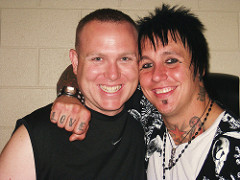 As far as the guys being involved in the project, they’re busy men and I try to leave them alone to do their jobs. That being said, Jacoby, Jerry, Tobin and Tony are some of the coolest guys you’ll meet and have answered every call and question I have asked. Whether you like their music or not, they are a kick-ass band and incredibly down to earth. I am lucky to have what little of an inside track as I do. I was given full access to the stage during sound checks to photograph the equipment; I mean I actually got to sit at the drums. When they were touring with Motley Crue, I was actually given a ‘Crue Skag’ for my birthday. Skags aside they are pretty excited about the project and want to see it finished as much as I do.
As far as the guys being involved in the project, they’re busy men and I try to leave them alone to do their jobs. That being said, Jacoby, Jerry, Tobin and Tony are some of the coolest guys you’ll meet and have answered every call and question I have asked. Whether you like their music or not, they are a kick-ass band and incredibly down to earth. I am lucky to have what little of an inside track as I do. I was given full access to the stage during sound checks to photograph the equipment; I mean I actually got to sit at the drums. When they were touring with Motley Crue, I was actually given a ‘Crue Skag’ for my birthday. Skags aside they are pretty excited about the project and want to see it finished as much as I do.
KG: I think it is fair to say that everywhere except LEGOLand (who just refuses to get on board) the all powerful minifig, and minifig-scale rules both the product line and the hobby in general. As the outspoken leader of the anti-minifig movement, would you care to outline your patently ridiculous stance?
DS: Anti-minifig, Keith? How could you do this to me? Twist my words… I thought we were friends! Saying I am anti-minifig is like saying that someone who is pro-life is anti-choice. I love those little dudes as much as the next guy! And I really like seeing the new diversity LEGO seems to be finding with its torso types and new flesh colors. I’ve done more than my fair share of vignettes like my armed robbery and ‘LifePod 23” and minifig only posts, ‘Blackstronauts’, “Boy Band” and even a concept for your ‘Fear the Black Planet’ contest. There is really a lot more fun to be had with the minifigure, and I am not going to count myself out of that action.
My gripe with the community is how much they seem to embrace minifig scale and none other. And even then, I think they have the scale all wrong. LEGO is a great medium and it often seems a shame to me that the majority of builders out there limit themselves to the worship of a little plastic doll. I would love to see more miniland scale MOCs and more sculpture produced on a regular basis.
More of Keith’s interview with Dave after the jump: Continue reading
Joe Meno: The real difference between European and American builders – Boilerplate & Beyond Vol. 12 [Interview]
For interview number 12, Keith Goldman turns to an Editor-in-Chief of a major LEGO media outlet not named Andrew. Take it away, Keith!
| If there is anyone in this hobby who has been there, done that, got the T-shirt, it is my next guest Joe Meno.
Joe hop-scotches the globe spreading the gospel of LEGO like some itinerate preacher from the American south. If there was ever an AFOL worthy of the title Ambassador in Perpetuity, it is the mighty Joe Meno. |
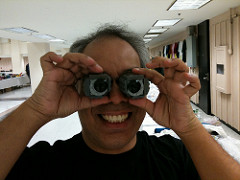
Photo courtesy of GeekyTom. |




